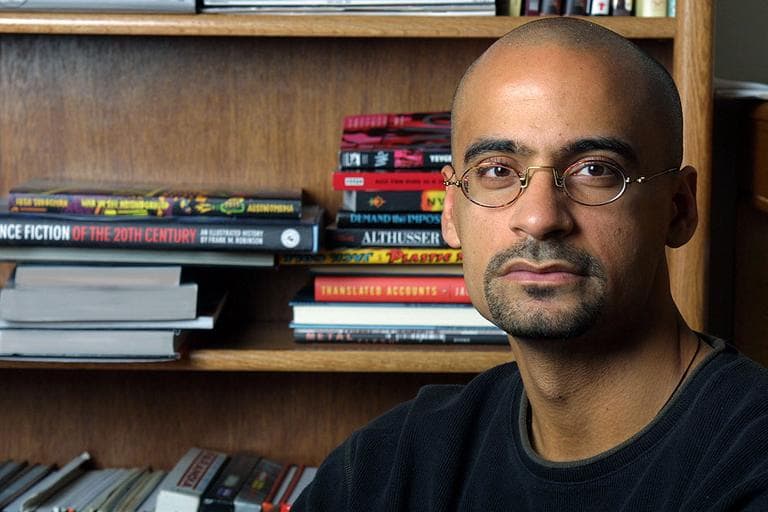Advertisement
Junot Diaz On What Disasters Reveal
ResumePulitzer Prize-winning novelist Junot Diaz on our arc of disasters—from Haiti to Japan to the Mississippi—and what it tells us about ourselves.

The Dominican-American writer Junot Diaz got everybody’s attention, and a Pulitzer Prize, with his fierce, funny, tragic first novel “The Brief and Wondrous Life of Oscar Wao.” Now, in a big new essay, Diaz has moved on to bigger themes — like apocalypse and the fate of the human race.
Junot Diaz looks at our recent headlines of earthquakes, tsunamis, meltdown fears, and floods and sees revelation. Not of the hand of God, exactly. But of human realities running amok.
We avert our eyes, he says. But these disasters must be read.
This hour, On Point: Junot Diaz, on revelation and apocalypse.
-Tom Ashbrook
Guest:
Junot Diaz, author and creative writing professor, Massachusetts Institute of Technology. He received the Pulitzer Prize for Fiction for his novel "The Brief Wondrous Life of Oscar Wao" in 2008. His essay, Apocalypse: What Disasters Reveal, appears in the May/June 2011 issue of The Boston Review.
Also, this hour:
This graduation season, we’re broadcasting excerpts from notable commencement addresses from around the country.
On Saturday, U.S. Supreme Court Justice Elena Kagan addressed the graduates of the University of New Mexico law school in Albuquerque. It was her first public address since being sworn in last summer. Justice Kagan told the 2011 graduates to be passionate about the work they do and find a way to give back.
Excerpt (PDF):
"Apocalypse: What Disasters Reveal"
By Junot Díaz
ONE
On January 12, 2010 an earthquake struck Haiti. The epicenter of the quake, which registered a moment magnitude of 7.0, was only fifteen miles from the capital, Port-au-Prince. By the time the initial shocks subsided, Port-au-Prince and surrounding urbanizations were in ruins. Schools, hospitals, clinics, prisons collapsed. The electrical and communication grids imploded. The Presidential Palace, the Cathedral, and the National Assembly building—historic symbols of the Haitian patrimony—were severely damaged or destroyed. The headquarters of the UN aid mission was reduced to rubble, killing peacekeepers, aid workers, and the mission chief, Hédi Annabi.
The figures vary, but an estimated 220,000 people were killed in the aftermath of the quake, with hundreds of thousands injured and at least a million—one-tenth of Haiti’s population—rendered homeless. According to the Red Cross, three million Haitians were affected. It was the single greatest catastrophe in Haiti’s modern history. It was for all intents and purposes an apocalypse.
TWO
Apocalypse comes to us from the Greek apocalypsis, meaning to uncover and unveil. Now, as James Berger reminds us in After the End, apocalypse has three meanings. First, it is the actual imagined end of the world, whether in Revelations or in Hollywood blockbusters. Second, it comprises the catastrophes, personal or historical, that are said to resemble that imagined final ending—the Chernobyl meltdown or the Holocaust or the March 11 earthquake and tsunami in Japan that killed thousands and critically damaged a nuclear power plant in Fukushima. Finally, it is a disruptive event that provokes revelation. The apocalyptic event, Berger explains, in order to be truly apocalyptic, must in its disruptive moment clarify and illuminate “the true nature of what has been brought to end.” It must be revelatory.
“The apocalypse, then,” per Berger, “is the End, or resembles the end, or explains the end.” Apocalypses of the first, second, and third kinds. The Haiti earthquake was certainly an apocalypse of the second kind, and to those who perished it may even have been an apocalypse of the first kind, but what interests me here is how the Haiti earthquake was also an apocalypse of the third kind, a revelation. This in brief is my intent: to peer into the ruins of Haiti in an attempt to describe what for me the earthquake revealed—about Haiti, our world, and even our future.
After all, if these types of apocalyptic catastrophes have any value it is that in the process of causing things to fall apart they also give us a chance to see the aspects of our world that we as a society seek to run from, that we hide behind veils of denials.
Apocalyptic catastrophes don’t just raze cities and drown coastlines; these events, in David Brooks’s words, “wash away the surface of society, the settled way things have been done. They expose the underlying power structures, the injustices, the patterns of corruption and the unacknowledged inequalities.” And, equally important, they allow us insight into the conditions that led to the catastrophe, whether we are talking about Haiti or Japan. (I do believe the tsunami-earthquake that ravaged Sendai this past March will eventually reveal much about our irresponsible reliance on nuclear power and the sinister collusion between local and international actors that led to the Fukushima Daiichi catastrophe.)
If, as Roethke writes, “in a dark time, the eye begins to see,” apocalypse is a darkness that gives us light.
But this is not an easy thing to do, this peering into darkness, this ruin-reading. It requires nuance, practice, and no small amount of heart. I cannot, however, endorse it enough. Given the state of our world—in which the very forces that place us in harm’s way often take advantage of the confusion brought by apocalyptic events to extend their power and in the process increase our vulnerability—becoming a ruin-reader might not be so bad a thing. It could in fact save your life.
This program aired on May 18, 2011.